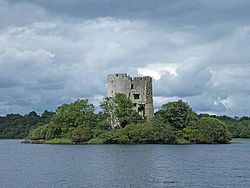| Cloughoughter Castle | |
|---|---|
| Cloch Locha Uachtair | |
 Cloughoughter Castle sits on an island in Lough Oughter Cloughoughter Castle sits on an island in Lough Oughter | |
 | |
| General information | |
| Location | Lough Oughter, Cavan |
| Country | Ireland |
| Coordinates | 54°01′07″N 7°27′17″W / 54.0187°N 7.4548°W / 54.0187; -7.4548 |
| Construction started | 1200 - 1224 |
| Demolished | 1653 |
| Client | William Gorm de Lacy |
| National monument of Ireland | |
| Official name | Clough Oughter Castle |
| Reference no. | 602 |
Cloughoughter Castle (Irish: Cloch Locha Uachtair, meaning 'stone castle of Loch Uachtair') is a ruined circular castle on a small island in Lough Oughter, 4 kilometres (2.5 mi) east of the town of Killeshandra in County Cavan, Ireland.
History
Origins and construction

The castle is located in the historic Kingdom of Breifne, specifically in the part that would later be subdivided into East Breifne, roughly corresponding to County Cavan. The spot may have been a crannóg, or an artificially created island, and it is possible there was fortification there as early as the sixth century. In the latter part of the 12th century, it was owned by the O'Rourkes, but early in the 13th century seems to have come into the hands of the Anglo-Norman de Lacy family. Architectural elements from the lower two stories show construction may have started as early as the first quarter of the 13th century.
In 1233, the O'Reilly clan took possession of the area and completed the castle. They retained it for centuries in the midst of their ongoing conflicts with the O'Rourkes, and with members of their own clan. It was there that Philip O'Reilly was imprisoned in the 1360s with "no allowance save a sheaf of oats for day and night and a cup of water, so that he was compelled to drink his own urine."
Post-1610
After the land confiscations that followed the Plantation of Ulster in 1610, Cloughoughter was granted to Captain Hugh Culme. In 1641, Philip O'Reilly, MP for Cavan and a prominent leader of the Irish Rebellion of 1641, seized control of the castle, which he held until 1653. During this phase of its existence, it was used as a jail, with Culme himself being one of the prisoners, along with his son-in-law Henry Jones. Another was William Bedell, Bishop of Kilmore in the Church of Ireland, who died in February 1642, evidently due to inadequate shelter from the cold winter.
In 1649 Owen Roe O'Neill, commander of the Ulster Army died at the castle. In March 1653, it was besieged by Commonwealth forces under Sir Theophilus Jones, brother of Henry and thus related by marriage to the Culme family. It was the last major Confederacy position to surrender on 27 April.
Jones set up his artillery in the nearby townland of Innishconnell and the damage caused by cannon shot remains to this day. Left in ruins, the castle became a frequent subject of art in the 18th and 19th centuries. Its visual impact was described in a travelogue published in The Dublin University Magazine in 1852:
It stands on a small island, scarce three hundred feet in diameter, just sufficient to contain the castle and a small margin of rock around it. The island stands in very deep water; the shores are a mile distant, wild, yet thickly wooded. The castle is a beautiful ruin, round, massive, hoary, save where mantled with rich Irish ivy. The walls are immensely thick, with embrasures and coved windows, round which "ruin greenly dwells." It is unlike most Irish castles, which are square.
Conservation efforts were begun on the castle in 1987. The structure is protected under the National Monuments Act.
References
Notes
- "National Monuments of County Cavan in State Care" (PDF). heritageireland.ie. National Monument Service. p. 1. Retrieved 2 July 2020.
- "Cloch Locha Uachtair / Cloghoughter Castle". Irish Placenames Database. Retrieved 2 December 2020.
- Kirker 1890, pp. 295–296.
- ^ "Cloughoughter Castle". IrelandsEye.com.
- Armstrong, Robert. "Culme, Sir Hugh". Dictionary of Irish Biography. Retrieved 1 September 2022.
- Kirker 1890, p. 297.
- McCullam 1856, p. 207.
- Religious Tract Society 1885, p. 747.
- Clarke 2004.
- Curry 1852.
- "Explore Cavan, Cloughoughter". oracleireland.com. Archived from the original on 26 February 2011.
- "National Monuments in State Care - County Cavan" (PDF). archaeology.ie. National Monuments Service. Retrieved 2 December 2020.
Sources
- Clarke, Aidan (2004). "Jones, Sir Theophilus". Oxford Dictionary of National Biography (online ed.). Oxford University Press. doi:10.1093/ref:odnb/15084. (Subscription or UK public library membership required.)
- Curry, William (1852). "A Pilgrimage to Quilea in the Year 1852". The Dublin University Magazine. XL (CCXXXI). William Curry, Jun., and Co.: 519. Retrieved 29 March 2011.
- Kirker, S.K. (1890). "Cloughoughter Castle, County Cavan". The Journal of the Royal Society of Antiquaries of Ireland. 1 (4): 294–297. JSTOR 25507754.
- McCullam, R. (1856). Sketches of the Highlands of Cavan, and of Shirley Castle, in Farney, taken during the Irish famine. J. Reed.
- Religious Tract Society (1885). The Sunday at Home. Religious Tract Society.
| National monuments of Ireland | ||
|---|---|---|
| Connacht |  | |
| Leinster | ||
| Munster | ||
| Ulster | ||
